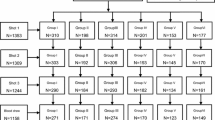Summary
To achieve a more rapid antibody response following hepatitis B (HB) vaccination, vaccine injections were given to medical students at considerably shorter intervals than usually recommended. They received 10 µg of the Merck Sharp & Dohme recombinant HB vaccine at time 0, 2 and 6 weeks (27 vaccinees) or were vaccinated according to the recommended schedule for pre-exposure HB prophylaxis (0, 1 and 6 months) (26 vaccinees). The short interval regimen resulted in a significantly higher frequency of protective antibody levels (≥10 IU/l) two weeks after the second dose of vaccine (48% vs. 4%; p<0.001), and all short interval vaccinees had seroconverted within two months (i. e. two weeks after the third dose). The recommended interval regimen resulted in a slower development of antibodies but significantly higher peak antibody levels after the completed three doses (p<0.001). The results indicate that protective antibody levels against hepatitis B virus (HBV) can be achieved more rapidly in humans through vaccination with short intervals. This short interval vaccination regimen, which has proved effective for post-exposure prophylaxis in chimpanzees, should possibly also be considered for post-exposure prophylaxis in humans, for instance after accidental exposure to HBV-contaminated blood.
Zusammenfassung
Um die Antikörperantwort nach Hepatitis-B(HB)-Impfung zu beschleunigen, wurden die Impfstoffinjektionen bei einer Gruppe von Medizinstudenten in erheblich kürzeren Abständen vorgenommen, als üblicherweise empfohlen wird. Die Applikation der rekombinanten HB-Vakzine (Merck Sharp & Dohme) erfolgte zum Zeitpunkt 0, 2 und 6 Wochen (27 Geimpfte) oder nach dem für die Prä-Expositionsprophylaxe für HB empfohlenen Schema (0, nach 1 und 6 Monaten) (26 Geimpfte). Die Dosis betrug jeweils 10 µg des Impfstoffs. Bei Anwendung des Applikationsschemas mit kurzen Dosierungs-intervallen waren zwei Wochen nach der zweiten Impfdosis signifikant häufiger protektive Antikörperspiegel (≥10 IU/1) nachzuweisen (48% gegenüber 4%; p<0,001); alle nach diesem Schema Geimpften hatten innerhalb von zwei Monaten (d. h. zwei Wochen nach der dritten Dosis) serokonvertiert. Bei dem empfohlenen Applikationsschema kam die Antikörperproduktion langsamer in Gang, erreichte aber nach Gabe aller drei Dosen signifikant höhere Antikörper-Spitzenspiegel (p<0,001). Mit einer Impfstoffapplikation in kürzeren Zeitabständen läßt sich folglich beim Menschen die Bildung protektiver Antikörperspiegel gegen Hepatitis-B-Virus (HBV) beschleunigen. Dieses Impfschema mit kurzen Dosierungsintervallen, das sich in der Prophylaxe nach Exposition bei Schimpansen bewährt hat, sollte eventuell auch beim Menschen als Schema für die Prophylaxe nach Exposition erwogen werden, beispielsweise nach versehentlicher Exposition gegenüber mit HBV kontaminiertem Blut.
Similar content being viewed by others
References
Szmuness, W., Stevens, C. E., Zang, E. A., Harley, E. J., Kellner, A. A controlled clinical trial of the efficacy of the hepatitis B vaccine (Hepavax B): A final report. Hepatology 1 (1981) 377–385.
Hadler, S. C., Francis, D. P., Maynard, J. E., Thompson, S. E., Judson, F. N., Echenberg, D. F., Ostrow, D. G., O'Malley, P. M., Penley, K. A., Altman, N. L., Braff, E., Shipman, G. F., Coleman, P. J., Mandel, E. J. Long-term immunogenicity and efficacy of hepatitis B vaccine in homosexual men. N. Engl. J. Med. 315 (1986) 209–214.
Wong, V. C. W., Ip, H. M. H., Reesink, H. W., Lelie, P. N., Reerink-Brongers, E. E., Yeung, C. Y., Ma, H. K. Prevention of the HBsAg carrier state in newborn infants of mothers who are chronic carriers of HBsAg and HBeAg by administration of hepatitis B vaccine and hepatitis B immunoglobulin. Lancet I (1984) 921–926.
Xu, Z. Y., Liu, C. B., Francis, D. P., Purcell, R. H., Gun, Z. L., Duan, S. C., Chen, R. J., Margolis, H. S., Huang, C. H., Maynard, J. E. US-China cooperative study group on hepatitis B. Prevention of perinatal acquisition of hepatitis B virus carriage using vaccine: Preliminary report of a randomized, double-blind placebo-controlled and comparative trial. Pediatrics 76 (1985) 713–718.
Iwarson, S., Wahl, M., Ruttiman, E., Snoy, P., Seto, B., Gerety, R. J.: Successful post-exposure vaccination against hepatitis B in chimpanzees. J. Med. Virol (in press).
Hollinger, F. B., Adam, E., Heiberg, D., Melnick, J. L.: Response to hepatitis B vaccine in a young adult population. In:Szmuness, W., Alter, H. J., Maynard, J. E. (eds.): Viral hepatitis Philadelphia, Franklin Institute Press, 1982, pp. 451–466.
WHO Expert Committee on Rabies. Tech. Rep. Ser. (1984) 709.
CDC-ACIP: Update on hepatitis B prevention. MMWR 36 (1987) 353–361.
Beasley, R. P., Hwang, L. Y., Lee, G. C. Y., Lan, C. C., Roan, C. H., Huang, F. Y., Chen, C. L. Prevention of perinatally transmitted hepatitis B virus infections with hepatitis B immune globulin and hepatitis B vaccine. Lancet II (1983) 1099–1102.
Stevens, C. E., Taylor, P. E., Tong, M. J., Toy, P. T., Vyas, G. N., Nair, P. V., Weissman, J. Y., Krugman, S. Yeast-recombinant hepatitis B vaccine. Efficacy with hepatitis B immune globulin in prevention of perinatal hepatitis B virus transmission. JAMA 257 (1987) 2612–2616.
Beasley, R. P., Hwang, L. Y., Stevens, C. E., Lin, C. C., Hsieh, F. J., Wang, K. Y., Sun, T. S., Szmuness, W. Efficacy of hepatitis B immune globulin for prevention of perinatal transmission of the hepatitis B virus carrier state. Final report of a randomized doubleblind, placebo-controlled trial. Hepatology 3 (1983) 135–141.
Grady, G. F., Lee, V. A., Prince, A. M., Gitnick, G. L., Fawaz, K. A., Vyas, G. N., Levitt, M. D., Senior, J. R., Galambos, J. T., Bynum, T. E., Singleton, J. W., Clowdus, B. F., Akdamar, K., Aach, R. D., Winkelman, E. I., Schiff, G. M., Hersh, T. Hepatitis B immune globulin for accidental exposures among medical personnel: Final report of a multicenter controlled trial. J. Infect. Dis. 138 (1978) 625–638.
Mc Lean, A. A. Development of vaccines against hepatitis A and hepatitis B. Rev. Infect. Dis. 8 (1986) 591–598.
Author information
Authors and Affiliations
Rights and permissions
About this article
Cite this article
Wahl, M., Iwarson, S. & Hermodsson, S. Hepatitis B vaccination with short dose intervals — A possible alternative for post-exposure prophylaxis?. Infection 16, 229–232 (1988). https://doi.org/10.1007/BF01650758
Received:
Accepted:
Issue Date:
DOI: https://doi.org/10.1007/BF01650758



